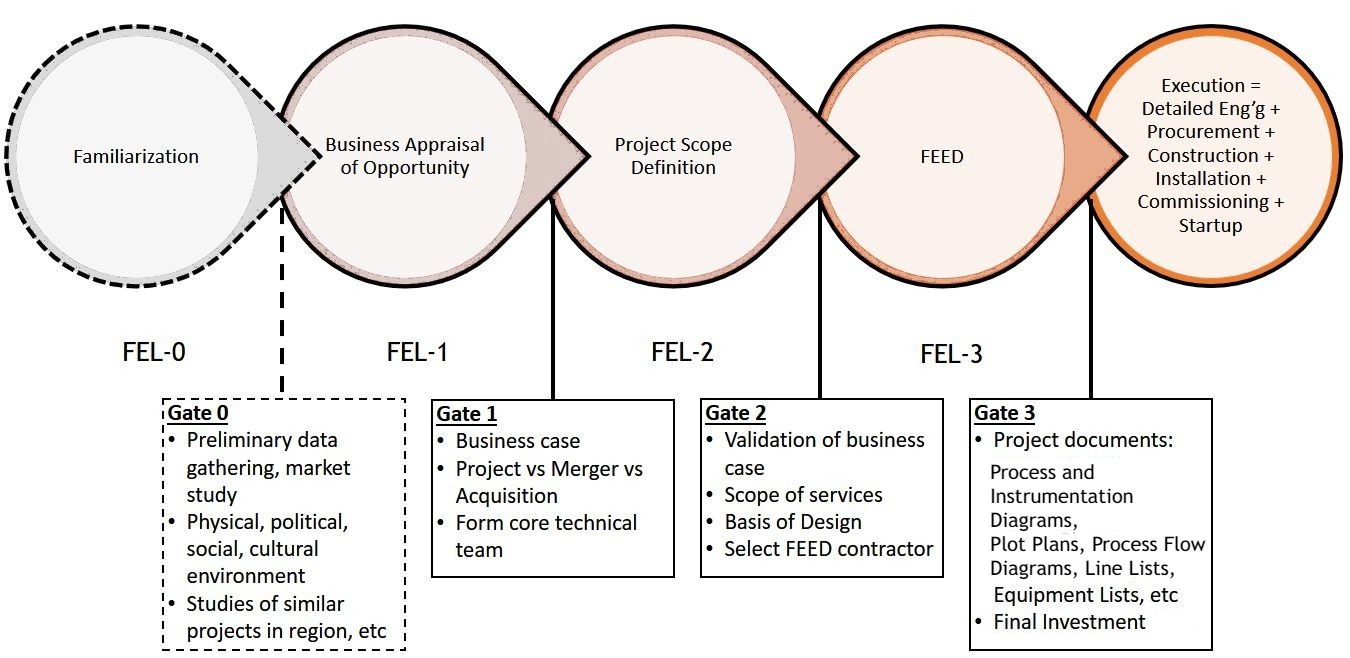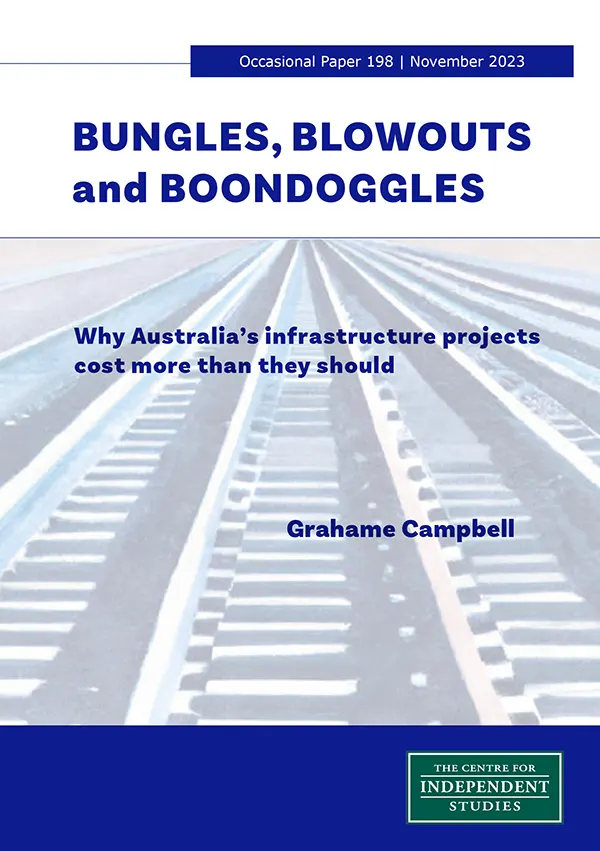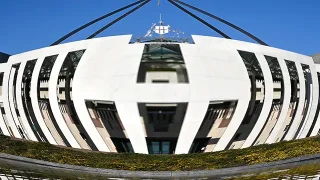
Bungles, Blowouts and Boondoggles: why Australia’s infrastructure projects cost more than they should:
Introduction
A large amount of taxpayers’ money, state and federal, is expended on large scale infrastructure that is intended to play a crucial part in Australia’s growth and prosperity — although some of it is arguably wasteful or perhaps even pork-barrelling. And as the recent federal government Infrastructure Investment Review found in axing around 50 planned projects, some “do not demonstrate merit, lack any national strategic rationale and do not meet the Australian Government’s national investment priorities. In many cases these projects are also at high risk of further cost pressures and/or delays.”[1]
But major infrastructure projects in Australia are often also more expensive than comparable projects in other countries,[2] even after even after adjusting for differences in currencies and purchasing power.
While a 2014 Productivity Commission Inquiry report on public infrastructure argued that there were examples where Australia was competitive internationally, and that the systematic evidence was missing or incomplete, it noted that several commentators argued Australia performed worse than other countries. The PC, while arguing for substantial reform to our infrastructure processes, also noted there was “considerable uncertainty about many facets of construction costs. There are sometimes large and inexplicable variations in the construction costs for what appear to be similar activities, such as the cost per kilometre of rail projects.”
It is unlikely that much has improved since 2014, especially given the findings of the recent review and estimates that construction costs increased more than 25% over the five years to mid-2022.[3]
There are several factors that contribute to the higher costs of major infrastructure in Australia. The available evidence on major infrastructure construction costs shows that there have been some recent significant increases in input costs. This particularly applies to labour and project management costs, plus contract design, complexity and poor management leading to risk offloading, cost over-runs and costly schedule over-runs. However, it is important to note that the cost of projects can also vary based on specific circumstances, project scope, and other factors.
As listed below, and explained in more detail in the subsequent sections related to costs, factors that can contribute to higher costs for Australian infrastructure projects include:
Labour and Industrial Relations: Australia generally has higher labour costs compared with many other countries. Wages, benefits, and labour regulations can contribute to higher project costs.
Lower Productivity: Productivity is hampered by the lack of a sufficiently educated, skilled and engaged workforce, an efficient work environment, innovation, efficient procurement models and ultimately trust between industry stakeholders.
Regulations and Standards: Australia has strict regulations and standards when it comes to construction, safety, and environmental considerations. Compliance with these regulations often adds to the complexity and cost of infrastructure projects.
Design Complexity: Infrastructure projects in Australia often involve complex engineering and design requirements. This can include considerations such as environmental impact, sustainability, and resilience, which may contribute to increased costs.
Project Management: Effective project management is crucial for successful infrastructure projects. Factors like inefficient planning, delays, and changes in scope can contribute to cost overruns.
Risk Offloading: Project cost is often inflated in Australia by a misguided focus on unloading risk in the early stages of a project’s development. This is often driven by the type of contract that is presented to the industry by lawyers, with the objective of minimising up-front costs and putting most of the risks on the contractors. This practice is not generally followed in other countries, which look at ‘whole of Life’ costs and benefits, resulting in a more cooperative and cheaper outcome.
Listen to this paper here:
Comparisons between Australia and overseas
The bespoke nature of many major projects makes finding comparisons of exact ‘like for like’ impossible. However, the following examples in the comparison section have been chosen for their general infrastructure similarities, and allow an approximate yardstick of costs in the relevant countries, which can be measured across factors such as track, road or tunnel length, number of stations, and so on, using the accepted purchasing price parity approach.[4]
However, as pointed out in a 2021 benchmarking report[5] by The Boston Consulting Group (BCG) for the Office of Projects Victoria (OPV):
When reviewing large-scale infrastructure projects, it is critical to note that each one is unique and faces its own pressures. The type of project undertaken, its overarching purpose, and difficulties posed by location, geology, resources and public needs and expectations can have significant impact on its outcomes.
Calculations are given below for comparison projects as approximately equivalent to A$ for 2022, the most recent whole year data available, using the following formula to account for purchasing power parity (PPP) and consumer price index (CPI): (US$ x AU PPP rate for year completed) x (CPI in 2022 / CPI in year completed) to give costs in approximate 2022 A$.
A more detailed calculation, but beyond the scope of this paper, could be obtained by the development and valuation of a hypothetical basket of items, known as the citiBLOC (BLOC = basket of locally obtained commodities).[6] The citiBLOC approach for construction uses a basket of representative items, including materials (various quantities of concrete, steel, glass, plasterboard and softwood studs); labour (electricians, carpenters, painters and unskilled labour at various total hours and charge out rates); and plant (mobile crane). Once raw cost estimates for the basket are obtained, they are converted to construction purchasing power parity,[7] as has been shown by Turner and Townsend.[8]
North East Link (Melbourne, Victoria)
The North East Link is a major road project in Melbourne, Victoria, designed to connect the Eastern Freeway with the Metropolitan Ring Road. It involves the construction of new road sections, tunnels, and interchanges to improve connectivity and alleviate traffic congestion in the north-eastern suburbs of Melbourne.
Approximately 26km. Approximately $16.5 billion.
The project is now estimated to cost at least $6.5 billion more than predicted: Approximately $16.5 billion, possibly up to $18 billion — according to a briefing to Victorian Treasurer Tim Pallas in 2021 — with the state government also announcing it would “absorb more of the risk”, meaning the taxpayer takes on more of the financial risk.[9]
The reasons for the increase include: the design now including a longer tunnel routed under sports fields;[10] the project announcement being made before the project was scoped or costed; the business case being based on excessive traffic growth and incorrect cost-benefit analysis (it is estimated to likely only return 70 cents per dollar invested, not $1.30).[11]
In addition, the granting of environmental approval for the road without a finalised plan for its route and estimation of impacts has led to a group of Melbourne councils agreeing to spend around $300,000 funding a Supreme Court legal challenge to the approval.[12]
Comparison projects
- I-4 Ultimate Improvement Project (Orlando, Florida)
Approximately 33.8km. Approximately US$2.3 billion, not yet completed (A$3.32b) - The Loop 202 South Mountain Freeway (Phoenix, Arizona)
Approximately 29km. Approximately US$1.7 billion, completed in 2019 (A$2.83b) - I-69 Section 5 (Bloomington to Martinsville, Indiana)
Approximately 33km. Approximately $325 million, completed in 2018 (A$547m) - I-4/Selmon Expressway Connector (Tampa, Florida)
Approximately 22km. Approximately US$550 million, completed in 2014 (A$979m).
Sydney Metro Rail Line (Sydney, New South Wales)
A new metro rail line connecting the north-western suburbs of Sydney to the city centre. It consists of multiple lines on the individual sections. The two sections are detailed separately below. Approximately up to an original estimated $20.5 billion in total.[13]
Sydney Metro Northwest section runs from Chatswood to Rouse Hill, serving suburbs in the northwest region of Sydney.
Approximately 36km and 8 stations. Approximately $8.3 billion.
Sydney Metro City and Southwest (under construction) will extend the line from Chatswood to Bankstown via the city centre.
Approximately 30km and 11 stations (inc extensions of existing stations). Approximately $11 billion.
The Sydney Metro project’s cost had already blown out to $21bn when a NSW government statement raised that estimate even further to $25.32bn — an overrun of at least $12bn, which Premier Chris Minns put down to being plagued by cost overruns and delays. The total cost of the city and south-west sections alone is $9bn over the initial estimation, with a current price tag of $20.5bn, according to the statement. The envisaged 2030 (at the earliest) operation of the western line is a delay of about five years.[14]
The interim report blamed a variety of factors, including: “poorly coordinated planning between government agencies, and an ambiguity of decision-making authority across government; contract packaging strategies where markets have subsequently evolved/changed risk appetite and capacity”; plus “avoidable matters relating to sub-optimal and delayed decision-making, arising in part from complex, complicated and lengthy governance arrangements; and disjointed planning and delivery efforts.”[15]
Specific planning factors that incurred extra costs including: the need to convert the (only recently completed) section of line from Chatswood to Epping, which included significant modifications to the electrification system, plus station modifications;[16] the need to adapt the existing North Shore Line to accommodate extra trains (including a costly but temporary upgrade to Hornsby station); and the Chatswood changeover requiring extra train capacity.[17]
Comparison projects
- Dubai Metro Route 2020 (Dubai, United Arab Emirates)
Approximately 15km and 7 stations. Approximately US$2.9 billion, completed in 2020 (A$4.7b) - Metro Line 14 (Paris, France)
Approximately 9km and 9 stations. Approximately US$4.7 billion, completed in 2020 (A$7.62b)
Sydney Light Rail (Sydney, New South Wales)
The Sydney Light Rail project (also known as the CBD and South East Light Rail) is a light rail/tram system with three passenger routes.
Approximately 24.7km. Approximately $2.9 billion.
A fourth line, the Parramatta Light Rail, is currently under construction and planned to open in May 2024.
Approximately 12km. Approximately $2.4 billion.
A report cited a $1bn blowout in the CBD and South East Light Rail secttion of the project, taking the cost to more than $3.1bn, or $158m more than the revised previous estimate of $2.9bn and a further $800m more than the original estimate of $2.1bn.[18] The report said the extra costs included close to $58 million extra due to delays, and $153m for enabling work that had not been included in the original planning estimates.[19]
Comparison projects
- Charlotte LYNX Blue Line Extension (Charlotte, North Carolina)
Approximately 15km. Approximately US$1.1 billion, completed in 2018 (A$1.85b) - Green Line (Minneapolis, Minnesota)
Approximately 18km. Approximately US$957 million, completed in 2014 (A$1.7b)
Westgate Tunnel (Melbourne, Victoria)
The Westgate project comprises twin tunnels under Yarraville between the West Gate Freeway and the Maribyrnong River, a 4km-long outbound tunnel and 2.8km-long city-bound tunnel. The project is due for completion in 2025 and will now cost a total of $10 billion instead of the $6.7 billion originally envisaged.
The project is now estimated to carry a blowout of an extra $1.9bn[20] and up to $3.3bn largely (but not entirely) due to an ongoing dispute about contaminated earthworks and soil disposal for the project site.[21]
The delay means the tunnel will now be completed at least two years later than originally planned, and the project’s builders are reported to believe the cost blowout could reach $5bn.[22]
Comparison projects
- Alaskan Way Viaduct Replacement Tunnel (Seattle, Washington). Approximately 3.2km
Approximately US$3.3 billion, completed in 2019 (A$5.49b) - Caldecott Tunnel Fourth Bore (San Francisco Bay Area, California)
Approximately 5.5km. Approximately US$417 million, completed in 2013 (A$753m) - Port Miami Tunnel (Miami, Florida)
Approximately 1.3km. Approximately $912 million, completed in 2014 (A$1.62b) - I-90 Snoqualmie Pass East Project (Washington State)
Approximately 4.4km. Approximately US$551 million, not yet completed (A$796m)
Factors that increase costs in Australia
Industrial Relations and Labour Costs
The impact of the industrial relations (IR) environment on the cost, productivity and performance of the construction industry has long been perceived as important. Labour costs, which are generally 45% of the cost of construction, have been rising as much as 5% per annum[23] over the past 15 years, despite (until very recently) low inflation and low general wage rises.
Persistent IR problems in the industry contributed to the creation in the mid-2000s of unique statutory provisions and institutional arrangements to govern IR. In 1982, the National Construction Industry Conference argued that IR problems were a major issue. Participants in the Industry Commission’s 1991 inquiry into construction costs considered that the IR system was an important driver of costs at that time, as did the 1992 Gyles Royal Commission into productivity in the building industry in New South Wales.
While the IR environment had changed by the late 1990s, the concerns had not evaporated. The Productivity Commission’s 1999 review of major building projects still found inefficient work practices and impediments to innovation.
The 2003 Cole Royal Commission was more severe in its judgment. It identified weak IR management by businesses, inadequate attention to Workplace, Health and Safety (WHS) issues, poor work practices, and unlawful union behaviours in the construction industry. Among other consequences, it considered that these practices and impediments had increased costs and reduced productivity. The Cole report gave impetus to industry-specific regulatory arrangements.
Since late 2002, oversight of the IR arrangements of the industry has been delegated to three successive specialist regulatory agencies — the Building Industry Taskforce (BIT), the Australian Building and Construction Commission (ABCC) and Fair Work Building and Construction (FWBC) — each with investigative and regulatory powers greater than those available in the generic IR system. In response to concerns from the Cole report about workplace health and safety, the Australian Government created the Office of the Federal Safety Commissioner in conjunction with the ABCC.
The existence of multiple state and federal IR law, codes and guidelines can lead to confusion; for example, each state has its own Workplace Health and Safety acts, while the Commonwealth also has its own federal regulations.
Contracting Practices
Contracting practices and market structure also influence the industrial relations environment. Public infrastructure projects typically involve a ‘principal contractor’ (which may involve a consortium of major construction companies) that does not have a large permanent workforce, but instead supervises many subcontractors to deliver a project.[24]
However, the principal contractor has responsibility for delivering the project. Factors such as the strength of their balance sheet are as important as their ability to mobilise a competent project management team.
Subcontractors often perform 80–90% of the total work value of a project. This employment and contracting model reflects that construction demand is cyclical and that major public infrastructure projects are site-specific and often require different skill mixes from project to project or at different phases of the project.
In that context, it is more efficient for a principal contractor to manage a site and engage subcontractors on a task-specific basis rather than carry the risks associated with underutilised capital equipment and personnel.
Further, Australia has a comparatively small number of Tier 1 Contractors (such as Lend Lease, John Holland and Thiess) — construction companies with the ability to complete most of the project with their own employees and equipment. Such contractors generally have strong balance sheets and can accommodate project risk.[25]
The construction industry and business groups have often pointed to problems in the IR environment in major construction projects, particularly in relation to:
- excessive terms and conditions and the creation of a wide range of complex allowances;
- unlawful or obstructive activities of some unions or officials;[26]
- control over the management of the site, including its WHS regime and monitoring, stipulations about hiring subcontractors and the organisation of rostering;
- the disruptive effects of go slows, work to order, overtime bans and strikes on the efficient management of a construction site; and
- identifying ‘dummy’ workplace health and safety issues as the basis for exercising power and bargaining.
However, the industry should avoid the temptation to focus on wages and industrial relations exclusively. While industrial relations are an important ingredient in the productivity debate, they are just one of many factors, as elaborated below.
Productivity
Concerns have been expressed regarding the apparent poor productivity performance of the industry in Australia,[27] and its perceived lack of performance compared with several of Australia’s international peers.[28]
Australia’s construction multi-factor productivity over the past 15 years has seen a net decline of 8.5%, which is ~16% below market-wide performance. While a significant factor in this decline can be attributed to increased safety improvements and regulations, according to Boston Consulting, “other industries, such as manufacturing, have managed to achieve both higher safety standards and productivity improvement over the same period.”[29]
It should be noted that productivity can be difficult to measure in service sectors such as construction where the output (completed infrastructure) can vary in quality over time.
However, overall high productivity is driven by an educated, skilled and engaged workforce, an efficient work environment, innovation, efficient procurement models and ultimately trust between industry stakeholders. The productivity debate needs to be significantly broadened to examine a range of potential sources of productivity improvement — including prefabrication and modularisation, more interactive procurement, better use of collaborative technology platforms, further industrial relations reform; and increasing the skill and expertise of the industry.
Real construction efficiency may be rising at about 1% per annum faster in the United States, and evidence exists to suggest that its top projects outperform anything found in Australia.[30] This may be due to a combination of technical, political and/or contextual factors.[31]
Regulations and Standards
Several Australian regulations and standards contribute to the higher costs of large infrastructure construction in Australia compared with the USA. Some key factors include:
Safety Regulations: Australia has strict safety regulations aimed at protecting workers and the public. These regulations often require additional safety measures, equipment, and training.
Environmental Regulations: Australia has robust environmental regulations to protect the natural environment and biodiversity. Compliance with these regulations can involve additional assessments, mitigation measures, and monitoring.
Labour Laws and Unionisation: Australia has comprehensive labour laws and strong union representation. This can result in higher labour costs, including wages, benefits, and associated labour regulations, compared with some parts of the USA.
Building Codes and Standards: Australia has rigorous building codes and standards that ensure the structural integrity, safety, and durability of infrastructure projects. Compliance with these standards can add complexity and cost to construction projects.
Accessibility and Disability Compliance: Australian regulations require infrastructure projects to meet specific accessibility and disability requirements, which can add to project costs.
Planning and Permit Processes: Australia has a thorough planning and permit process for infrastructure projects. The need to obtain various permits, conduct environmental assessments, and consult with stakeholders can result in delays and increased costs.
Material Standards and Quality Control: Australian regulations enforce high-quality standards for construction materials and require rigorous quality control measures. This ensures the durability and longevity of infrastructure projects but may contribute to higher material costs.
The client is often inexperienced in infrastructure procurement and risk-averse, and will require ‘gold standards’ in all the areas outlined above, when a lower standard may be appropriate.
While these regulations and standards contribute to higher costs, they also serve important purposes such as ensuring safety, environmental sustainability, and accessibility. The specific impact and cost implications can vary depending on the project and location within Australia. As illustrative examples, this paper will outline two relevant areas: water management and user amenity standards.
Water Management for Road and Rail Development
Road and rail projects in the urban environment can lead to significant changes in catchment hydrology, with the most obvious effect being the increase in the magnitude of stormwater flow events in urban creeks and the consequential impact on flooding and public safety. The need to attenuate peak flood flows has added cost, as has the need to achieve water quality goals.
Construction of attenuation structures (basins) and water quality devices has added to the cost of construction, and has increased the land requirements (the footprint) of most projects. However, Australia is not unique in this among ‘first world’ countries.
Traditional stormwater management has focussed on the issue of drainage, where the principal (and often the only) objective of engineering works was to safely and economically convey stormwater runoff from the local areas to the receiving waters. The quantity and rate of stormwater runoff generated from impervious surfaces then led to extensive channel erosion and an increased frequency of flooding.
Stormwater management in urban catchments now places more emphasis on meeting multiple objectives, including that of drainage, flood protection, ecosystem protection and the optimisation of recreational and landscape opportunities. All of this increases the cost of road and rail construction.
Long-Term User Amenity
Changing design life and user amenity standards in Australia can also increase the cost of delivering major infrastructure projects. The design life issue can manifest itself in increased requirements for waterproofing, permanent support systems, corrosion protection, fire resistance, flood proofing, material specifications, etc.
User amenity and safety now adds new requirements such as lifts in escape tunnels, smoke ducts, heightened air quality limits, breakdown lanes, security, traffic management and emergency systems including fire controls.
Design Complexity
Infrastructure projects in Australia often involve complex engineering and design requirements due to various factors.
Geographic and Environmental Factors: Australia’s diverse geography, including coastal areas, mountainous regions, and expansive deserts, often requires engineering solutions tailored to specific environments. Projects must consider factors such as seismic activity, flood mitigation, cyclone resistance, and coastal erosion.
Population Density: While Australia has a relatively small population compared with its vast land area, major cities are often densely populated, while areas outside them are often sparsely populated. This necessitates careful design and engineering to accommodate high traffic volumes, ensure efficient transportation networks, and minimize disruptions to existing infrastructure and communities.
Sustainable and Resilient Design: Australia places a strong emphasis on sustainable and resilient infrastructure. Projects need to incorporate energy-efficient design, water conservation measures, waste management strategies, and climate change adaptation considerations to ensure long-term sustainability.
Compliance with Regulations and Standards: Australia has stringent regulations and standards governing infrastructure projects. These include building codes, safety requirements, accessibility guidelines, environmental regulations, and cultural heritage protection measures. Compliance with these regulations adds complexity and can impact project design and costs.
Indigenous Engagement and Cultural Heritage Protection: Australia has a strong commitment to engaging with Indigenous communities and protecting cultural heritage sites. Infrastructure projects often involve extensive consultation, impact assessments, and mitigation measures to respect and preserve Indigenous cultural values and heritage.
Some specific engineering and design requirements that add complexity to infrastructure projects in Australia include:
- Geotechnical considerations for varying soil conditions
- Structural design to withstand earthquakes and cyclonic events
- Flood mitigation and drainage systems
- Sustainable water management and conservation measures
- Traffic flow optimization and transport network planning
- Noise and vibration reduction strategies
- Consideration of biodiversity and habitat preservation
- Coastal erosion protection and sea-level rise adaptation
- Cultural heritage impact assessments and preservation measures
These engineering and design requirements ensure that infrastructure projects in Australia meet high standards of safety, sustainability, functionality, and resilience in line with local regulations and community expectations, but these come at a cost.
Poor Project Management
Poor project management can undermine large infrastructure projects in several ways.
- Inadequate project management can lead to cost overruns, where the project exceeds its budgeted expenses.[32] This can result from poor cost estimation, ineffective cost control, lack of proper risk assessment and management, or inefficient procurement practices. Cost overruns can strain project finances, lead to funding issues, and potentially compromise the completion of the project.
- Poor management can cause significant delays in project timelines. Ineffective planning, insufficient resource allocation, lack of coordination among stakeholders, and inadequate risk mitigation strategies can contribute to schedule disruptions. Delays can have a cascading effect on subsequent project phases, impact the overall project timeline, and a knock-on effect of resulting in additional costs.
- Insufficient oversight, lack of quality control processes, and inadequate monitoring of construction activities can lead to subpar workmanship, non-compliance with specifications, and compromised safety standards. leading to costly rework and maintenance issues.
- Poor project management can lead to inefficient allocation of resources, including labour, materials, and equipment. Ineffective resource planning, inadequate supply chain management, and lack of coordination among different project teams can result in unnecessary expenses, increased project duration, and compromised productivity.
To understand how construction is delivered in Australia you have to analyse who are the players and what inputs are required.
In simple terms, all infrastructure projects have a common set of players:
- Owners
- Project Managers
- Consulting Engineers
- Constructors
- Equipment Suppliers
- Material and Equipment Manufacturers
- Government Agencies
- Approval Certifiers
- Financiers
- Lawyers and Accountants
All these groups have engineering input but are governed by different imperatives. Understanding how all of these players relate to each other and the obligations each has to the project are generally set out in contracts and agreements.
The key role is project management, but several of the above groups aspire to this role. Owners, consulting engineers, constructors, equipment suppliers and sometimes specialist project managers have been contracted to play this role to some degree. The owners make the ultimate decision, which is often based on advice from financers and lawyers derived from risk management assessments. Because lawyers and financers have limited knowledge of project management, their advice can be biased to a false judgement of risk avoidance.
In addition, large infrastructure projects are often fast-tracked for political reasons and may go to market before they are ready, or see the client (politician) keep changing goalposts — for example, expected flood mitigation or traffic levels — during the planning phase.
Ultimately, such projects often fail to complete on time or within budget from the simple fact that definition of the project is poorly expressed, leading to poor project management. A study by Independent Project Analysis, Inc reported that 74% of completed large and technically complex projects in Australia had been failures, in terms of going over schedule or over budget,[33] often due to deficiencies or omissions during planning of the projects before they were even approved for execution.
Type of Contract / Procurement
The type of procurement contract can have a significant impact on the costs of large infrastructure projects. Different procurement methods have distinct characteristics and allocation of risks, which can influence project costs in various ways. The impact of procurement contracts on costs is complex and can vary depending on project-specific factors, local regulations, market conditions, and the capabilities of the contracting parties.
A well-designed procurement strategy that considers project objectives, risk allocation, market dynamics, and value for money can help optimize costs and achieve project success. Future work in this area could analyse the different kinds of procurement to determine the most cost-efficient ones for public infrastructure projects that rely on taxpayer dollars.
Unloading Risk
As it currently stands, all project management is overwhelmed in Australia by a misguided belief that unloading risk in the early stages of a project’s development will yield the best result for the owner.
In Australia, it’s all to do with the type of contract that is presented to the industry by the lawyers. It’s driven by the objective of minimising up-front costs and putting most of the risks on the contractors.
The problem is that it is much more cost-effective to reduce risk at the front end rather than unload it when it arises. It would make more sense to solve the problems that can be solved early, such as geological issues or flood risks. If you do that up front, it mitigates the risk, rather than just ignoring it and having it lead to the contractor increase the price because of the risk being offloaded to a later stage of the development.
The practice of ‘unloading risk’ can adversely impact large infrastructure projects in Australia in several ways:
Cost Overruns: When project risks are shifted predominantly to contractors or subcontractors through contractual agreements, they may price these risks into their bids. This can result in higher contract prices and potential cost overruns for the project owner. If risks are not adequately managed or allocated, unexpected costs can arise, impacting project budgets and financial viability.
Disputes and Litigation: Unloading risk without proper clarity or mitigation measures can lead to disputes and legal battles between project stakeholders. Ambiguities or disagreements regarding risk allocation can result in delays, increased costs, and even project suspension or termination. Resolving these disputes can be time-consuming and expensive, further impacting project timelines and budgets.
Reduced Innovation and Quality: Contractors may focus on minimising risk rather than pursuing innovative solutions or emphasizing quality. Unloading risk can discourage contractors from taking on new technologies or approaches that may carry uncertainties. This can hinder project outcomes and limit potential advancements in infrastructure design and construction.
Adverse Contractor Selection: If contracts heavily unload risk onto contractors without adequate compensation or risk-sharing mechanisms, such as the discovery and mitigation process to minimise the risk, it may discourage qualified and capable contractors from bidding on projects. This can limit competition, reduce the pool of experienced contractors, and potentially lead to the selection of less capable or underqualified contractors.
Adverse Project Delivery: The practice of unloading risk can create an adversarial environment between project stakeholders, including owners, contractors, and subcontractors. This can hinder effective collaboration, communication, and coordination, negatively impacting project delivery and performance.
Reputation and Public Perception: Infrastructure projects that experience significant issues related to risk unloading, such as cost overruns, disputes, or delays, can harm the reputation of the project owner, contractors, and the broader industry. Public perception of large infrastructure projects may suffer, leading to a lack of public trust and support for future projects.
Opportunities for reducing costs
In 2009, the US National Research Council conducted a comprehensive study of areas that might deliver significant productivity improvements in the US construction industry. It identified the following as key areas for reform, and these would also reduce costs in Australia:
- Widespread deployment and use of interoperable technology applications, also called Building Information Modelling (BIM)
- Improved job-site efficiency through more effective interfacing of people, processes, materials, equipment, and information
- Greater use of prefabrication, preassembly, modularization, and off-site fabrication techniques and processes
- Effective performance measurement to drive efficiency and support innovation — although this can be difficult in the often-combative relationships that procurement practices produce.
Improving Productivity and Labour Costs
Reducing the costs associated with labour and industrial relations in large infrastructure projects can be a complex task. However, several approaches can help mitigate these costs.
Implementing effective workforce planning strategies can help optimize labour costs. This involves accurately assessing the required workforce capacity and skills throughout different project stages and aligning them with project timelines. Proactive planning ensures the right number of workers are engaged at the right time, minimizing unnecessary labour costs.
Employing a competitive bidding process when awarding contracts can incentivise contractors to offer cost-effective labour solutions. Evaluating proposals based on both cost and quality criteria ensures a balanced approach to contractor selection, promoting fair competition and potential cost savings.
Investing in the training and development of the local workforce can enhance productivity and reduce reliance on expensive overseas or specialized labour. Collaborating with educational institutions, providing apprenticeships, and offering upskilling programs can contribute to a more skilled and cost-effective labour force.
Embracing technological advancements and automation can help optimise labour costs by increasing productivity and efficiency. Implementing innovative solutions such as advanced machinery, robotics, and digital tools can reduce the need for manual labour, improve safety, and enhance project outcomes.
Efficient project management practices, including accurate cost estimation, scheduling, and monitoring, can help control labour costs. Clear communication, coordination, and risk management strategies contribute to minimising disruptions and avoiding unnecessary labour expenses.
Reviewing and streamlining labour and industrial relations regulations can promote more flexible and efficient labour practices. Collaborating with relevant government agencies to identify areas for improvement and implementing reforms that balance worker rights with project requirements can contribute to cost reductions. Crucially, reducing labour costs should not compromise worker safety, fair wages, or labour standards.
Better Project Definition
Many large project failures are due to poor project definition. A couple of current examples illustrate this.
Inland Rail Project: The project has been under construction for some years. A recent independentreview found the start and end points have not been determined.[34] Flood mitigation studies have not been completed. The cost and time to complete have probably doubled. The route has not been finalised in several places. There is no project manager. The federal government was initially reported to be investing $16.4 billion to develop and build Inland Rail,[35] however the review said the cost of the project had risen to more than $31 billion.[36]
Westgate Tunnel: Full sign-off of excavation material for the tunnel construction was not achieved before the start of construction. The material was condemned, and major delays occurred. The new toll road, built by Transurban, is running at least two years behind its original timeframe, and the cost has blown out to $10 billion – almost double Transurban’s original estimate. The project was originally due to be completed by 2023 and is now not expected to be finished before 2025.
However, there are some recent examples of projects in Australia that have been delivered successfully. The project teams for both focused on extensive early definition and collaboration to construct an integrated team to manage the overall development.
WestConnex: The cost of the project was $16.8 billion. Capital investment was delivered on budget and two and a half months early. The project was divided into four major fixed price design and construct packages. There was extensive geotechnical investigation to allow informed design development. Reasonable risk-sharing arrangements, on things like contaminated soil and extension of time provisions, were agreed at the outset, but most importantly a performance-based specification allowing the contractor to develop the most cost-effective design was agreed. This was all developed and agreed on before contracts were signed.
Allianz Stadium: The project was built for $829 million on time and budget. Design and construct with architectural detail was managed by a novated architect but most solutions were left to the contractor. There was very experienced clients representative from Infrastructure NSW. John Holland’s project director had previously successfully delivered the Bradman Noble and Trumper Stands at the SCG. There was a very experienced construction engineer (ex Transfield) managing for Venues NSW. There was also a practical and fair Project Control Group, where issues were sorted out on a whole of project basis with no claims outstanding at the end. All these people had a mature and integrated approach to successful project outcomes.
Essentially the problem is simple. Define the project properly with a competent design. Capture ‘whole of life’ value for the project. Once construction starts, don’t change the design. Experience has shown that infrastructure projects can be delivered successfully when:
- A mature approach is taken to assessing claims;
- Competent and experienced personnel are mobilised by all parties;
- The project is defined properly at the outset with a competent design;
- A ‘whole of life’ approach is taken to assessing the value of the project; and
- The scope of the project is not changed once construction has started.
Better Geological and Topographical Investigation
Geological surprises such as unexpected types of rock and other sub-surface issues, are a major reason that projects are delayed and go over budget. Discrepancies between ground conditions found during construction and the results of early ground investigation can require costly last-minute changes to project scope and design.
New techniques that integrate high-definition photography, 3-D laser scanning, and geographic information systems, enabled by recent improvements in drone and unmanned-aerial-vehicle (UAV) technology, can dramatically improve accuracy and speed.
Photogrammetry, for example, provides high-quality, high-definition images of survey areas — although this previously took time to be converted into a usable format. Increased use of today’s faster aerial light-detection-and-ranging (lidar) technology is much faster and provides high-quality 3-D images that can be integrated with project-planning tools, such as Building Information Modelling (BIM).
Digital Engineering
The construction industry should increase adoption of integrated software platforms such as Revizto and BIM360 that span project planning, collaboration, design, construction, operations, and maintenance, allowing workflows to be streamlined. The industry can no longer afford to rely on bespoke software tools or different platforms that do not sync with one another.
For example, the 97km Pacific Highway Woolgolga to Ballina highway upgrade project, which was undertaken by Tier 1 contractors including Lend Lease, CPB Contractors, and numerous subcontractors, experienced coordination difficulties using Navisworks, which didn’t allow free exchange of project-related data.
Next-generation 5-D BIM is a five-dimensional representation of the physical and functional characteristics of any project. It considers a project’s cost and schedule in addition to the standard spatial design parameters in 3-D. It also includes such details such as geometry, specifications, aesthetics, thermal, and acoustic properties. A 5-D BIM platform allows owners and contractors to identify, analyse, and record the impact of changes on project costs and scheduling. The visual and intuitive nature of 5-D BIM gives contractors a better chance to identify risks earlier and thus to make better decisions. For example, project planners can visualize and estimate the impact of a proposed change in design on project costs and schedule.
Digital Engineering may be defined as the convergence of emerging technologies such as BIM, Geographic Information Systems (GIS) and related systems to derive better business, project and asset management outcomes. Digital Engineering enables a collaborative way of working using digital processes to enable more productive methods of planning, designing, constructing, operating and maintaining assets through their life cycle.
There should be an acceleration of digital engineering (incorporating BIM) in the delivery and management of buildings and infrastructure assets and networks. Digital engineering offers many benefits throughout the asset lifecycle and has the potential to drive efficiency, value for money, productivity and innovation. However, the application of digital engineering for infrastructure sectors presents a diverse set of challenges as assets can vary in nature from being discrete in stand‐alone buildings, to linear when forming part of a broader network.
Better Project Management
Effective project management practices should be implemented, including robust planning, accurate cost estimation, comprehensive risk management, strong stakeholder engagement, regular monitoring and reporting, proactive issue resolution, and adherence to industry best practices.
An enterprise-based model of integrated delivery teams has been pioneered by the Project 13 Initiative coming from the UK. This sets out a delivery model based on:
effective collaboration between client organisations, contractors and other delivery partners. It defines value within the context of overall outcomes per whole life cost rather than lowest capital cost. The objective is to deliver high performing and resilient infrastructure networks.[37]
Such a model would represent a departure from current practice, where transactional bi-lateral relationships that largely exist on a project-by-project basis, which along with unbalanced risk and commercial models, drive an adversarial culture and a financially unsustainable industry.
FEED project management
For more than 50 years the oil and gas industry has developed protocols to manage the development of new projects. The concept of Front End Engineering Design [FEED] has been developed over many years. A competent engineering group is retained to work with the owner to define the scope of the project and perform on site investigations to ascertain potential risks.
A series of ‘gates’ is established to review outcomes of the preliminary design and the site investigations as they unfold. Community consultation is incorporated into this process. Potential contractors and suppliers are also contacted and kept abreast of the project details and asked for any suggestions that might facilitate better execution during the development. As the project becomes clearer, cost and schedule estimates are developed and refined as the design details are agreed amongst the owners and engineers.
Potential contracting strategies are tabled to test the ability of the local market to respond positively to the project. As the detailed design advances the availability of specialised equipment and the need for high tech systems is identified.
Once all the ‘gates’ have been cleared the board can vote on a Final Investment Decision’ FID’.

Projects follow a stage-gated approach that includes Front-End Loading (FEL),[38] in which the team appraises the opportunity before selecting the scope at FEL 2A. Scope development is completed in FEL 2B, followed by FEED activities and FEL 3 such as execution planning. If the governance process is working, decisions are made at the gates that separate these phases. Business commitment happens at the end of FEL 2B and the final investment decision (FID) is taken at the end of FEL 3.
Flowchart Source: Dangote Industries Ltd.[39]
More than 30 years ago this process was implemented for the first private toll road in the new era, the M4 motorway in Sydney. This is the highest density road corridor in Australia. The project management structure allowed the contracting strategy to avoid a principal contractor and divide the work into 35 packages to be managed by the project manager, StateWideRoads. This allowed a broad range of suppliers and builders to become involved in the work.
By the time construction commenced, the management of utilities, the support of local councils and community groups, and the endorsement of affected government departments had been achieved during the FEED stage. Any subsequent objections were dealt with quickly to avoid interference with onsite works.
At the end of the construction and after the transit of the first customer cars it was noted that the project had been completed in half the time and at half the cost estimated by the government initially.
Risk Offloading
As outlined above, risk offloading a very poor practice — that is generally not followed by overseas countries. In other countries, the project will look at ‘whole of life’ costs and rewards. This tends to create a more cooperative and cheaper outcome.
It is important for project stakeholders to carefully consider risk allocation, ensure contracts are fair and balanced, and implement robust risk management strategies to mitigate the negative impacts associated with unloading risk. Collaborative and transparent approaches to risk allocation can help optimise project outcomes, improve cost certainty, and foster successful project delivery.
Integration across the construction industry will drive a better-performing infrastructure industry. To achieve this, a new model for delivery is required to transform the infrastructure sector in Australia, one founded in long-term, collaborative, and trust-based relationships.
This requires regular two-way dialogue between the government and industry. It also requires an integration of delivery teams with the client. It does not eliminate the possibility of competitive bidding for work packages along the way.
Conclusion
In summary, several approaches can be implemented to help reduce the costs of major infrastructure projects in Australia.
Optimal Resource and Productivity Management: Efficient resource management, including labour, materials, and equipment, can help control costs. Careful workforce planning, strategic sourcing of materials, and maximizing equipment utilization can lead to cost savings and improved project efficiency.
Efficient Planning and Design: Thorough and well-considered planning and design can optimize project costs. Conducting comprehensive feasibility studies, engaging experienced design professionals, and considering alternative design options can help identify cost-effective solutions while maintaining project objectives.
Competitive Bidding and Procurement: Promoting competition through transparent and competitive bidding processes can help drive down costs. Encouraging multiple qualified contractors to submit competitive bids can lead to more favourable pricing and improved value for money.
Robust Risk Management: Carefully consider risk allocation, ensure contracts are fair and balanced, and implement robust risk management strategies to mitigate the negative impacts associated with unloading risk. Implement effective risk management strategies to mitigate potential cost overruns. Identifying and assessing project risks, developing contingency plans, and regularly monitoring and managing risks throughout the project lifecycle can help minimise unexpected expenses.
Streamlined Approval Processes: Simplifying and streamlining approval processes can reduce project delays and associated costs. Collaborating with regulatory authorities to identify and address potential bottlenecks, implementing efficient permitting procedures, and leveraging digital technologies for streamlined documentation can expedite project timelines.
Embracing Innovation and Technology: Adopting innovative construction techniques and technologies can drive cost savings. Embracing Building Information Modelling (BIM), modular construction, prefabrication, and other advancements can enhance productivity, reduce waste, and shorten construction durations.
Effective Project Oversight: Establishing strong project oversight and governance structures can enhance cost control. Regular monitoring, reporting, and review of project performance, financials, and deliverables can help identify potential cost issues early and implement corrective measures.
Implementing a combination of these strategies, tailored to the specific needs and characteristics of each project, can contribute to reducing costs and improving the overall efficiency of major infrastructure projects in Australia.
Endnotes
[1] Federal Minister for Infrastructure, Transport and Regional Development. 2023. Infrastructure Investment Review. https://www.infrastructure.gov.au/sites/default/files/documents/independent-strategic-review-iip-project-changes-summary.pdf
[2] The Australian 2012. “Local project costs 40pc above the US, says Business Council of Australia”, June 7, available at: http://www.theaustralian.com.au/national-affairs/localproject-costs-40pc-above-the-us/story-fn59niix-1226386836012
[3] Property Australia, 2022. Construction costs set to peak this year as Australia records fourth highest cost of labour in the world. https://info.propertycouncil.com.au/property-australia-blog/construction-costs-set-to-peak-this-year-as-australia-records-fourth-highest-cost-of-labour-in-the-world
[4] Best, R. 2008. “The development and testing of a purchasing power parity method for comparing construction costs internationally”, PhD thesis, University of Technology, Sydney.
[5] Boston Consulting Group/Office of Projects Victoria, 2021. International Major Infrastructure Projects Benchmarking Review https://www.vic.gov.au/sites/default/files/2023-02/International-Major-Infrastructure-Projects-Benchmarking-Review.pdf, p8
[6] Langston C. 2016. Centre for Comparative Construction Research (Bond University). The Reliability of Currency and Purchasing Power Parity Conversion for International Project Cost Benchmarking, https://www.pc.gov.au/inquiries/completed/infrastructure/submissions/submissions-test2/submission-counter/subdr112-infrastructure.pdf p7
[7] Walsh, K. and Sawhney, A. 2004. International comparison of cost for the construction sector: an implementation framework for the basket of construction components approach
[8] Turner and Townsend. 2022. International construction cost survey 2022, available at: https://www.turnerandtownsend.com/en/perspectives/international-construction-market-survey-2022/
[9] Herald-Sun. 2021. North-East Link valuation sparks fears of another budget blowout. https://www.heraldsun.com.au/news/victoria/north-east-link-valuation-sparks-fears-of-another-budget-blowout/news-story/db669b16533b9b1a23c9ae903781fa29
[10] 9News. North-East Link freeways costs lift $6.5 billion. https://www.9news.com.au/national/north-east-link-freeway-costs-lift-6-point-5-billion-dollars/25111f58-ee07-46f2-8418-0753e887ea69
[11] William McDougall. 2020. North-East Link the perfect storm. https://wmcdougall.com/2020/09/21/north-east-link-the-perfect-storm/
[12] The Age. 2020. Councils justified in legal challenge to North-East Link. https://www.theage.com.au/politics/victoria/councils-justified-in-legal-challenge-to-north-east-link-20200211-p53zsv.html
[13] Australia New Zealand Infrastructure Pipeline. https://infrastructurepipeline.org/project/sydney-metro
[14] Guardian Australia. 2023. NSW government launches Sydney Metro review amid $21bn cost blowout. https://www.theguardian.com/australia-news/2023/apr/13/nsw-government-launches-sydney-metro-review-amid-21bn-cost-blowout
[15] Sydney Metro Independent Review Interim Report. 2023. https://www.sydneymetro.info/media/document/35771
[16] The University of Sydney Business School. 2023. Taken for a ride: the real cost of Sydney’s Metro railways. https://www.sydney.edu.au/business/news-and-events/news/2023/01/09/taken-for-a-ride–the-real-cost-of-sydney-s-metro-railways.html
[17] International Railway Journal. 2022. Sydney Metro City and Southwest project exceeds budget by US$3.5bn. https://www.railjournal.com/passenger/metros/sydney-metro-city-and-southwest-project-exceeds-budget-by-us-3-5bn/
[18] Government News. 2020. Cost of Sydney light rail blows out, reporting questioned. https://www.governmentnews.com.au/cost-of-sydney-light-rail-blows-out-reporting-questioned/
[19] International Railway Journal. 2022. Sydney Metro City and Southwest project exceeds budget by US$3.5bn. https://www.railjournal.com/passenger/metros/sydney-metro-city-and-southwest-project-exceeds-budget-by-us-3-5bn/
[20] The Age. 2021. Westgate Tunnel project to cost state extra $1.9bn. https://www.theage.com.au/national/victoria/west-gate-tunnel-project-to-cost-state-extra-1-9-billion-20211216-p59i67.html
[21] Ground Engineering. 2021. Westgate Tunnel faces higher construction costs due to contaminated soil. https://www.geplus.co.uk/news/west-gate-tunnel-faces-higher-construction-costs-due-to-contaminated-soil-woes-11-08-2021/
[22] Australian Financial Review. 2021. Transurban confirms $3.3bn blowout on
Westgate Tunnel. https://www.afr.com/companies/infrastructure/transurban-confirms-3-3b-blow-out-on-west-gate-tunnel-20210809-p58gzo
[23] Australian Bureau of Statistics. 2022. Analytical measures of labour costs. https://www.abs.gov.au/articles/analytical-measures-labour-costs
[24] Edvardsen, D.F. 2005. “Economic efficiency of contractors”, in proceedings of 11th Joint CIB International Symposium Combining Forces: Advancing Facilities Management and Construction through Innovation.
[25] Iseekplant. 2022. Complete List of Australia’s Tier 1, Tier 2 and Tier 3 Contractors. https://blog.iseekplant.com.au/blog/complete-list-of-australias-tier-1-tier-2-and-tier-3-contractors-and-builders
[26] The Courier Mail. 2021. Master Builders finds building costs with CFMEU increase 30 per cent. https://documents.parliament.qld.gov.au/tp/2021/5721T296.pdf
[27] Australian Constructors Association. 2022. Disrupt or Die: Australia’s construction industry is at a crossroads. https://www.constructors.com.au/disrupt-or-die-australias-construction-industry-is-at-a-crossroads/
[28] KPMG. 2023. Productivity gains and risk rebalance vital to survival of Australian construction
KPMG Global Construction Survey 2023. https://kpmg.com/au/en/home/media/press-releases/2023/06/productivity-gains-risk-rebalance-vital-survival-australian-construction-june-2023.html
[29] Boston Consulting Group/Office of Projects Victoria, 2021. International Major Infrastructure Projects Benchmarking Review https://www.vic.gov.au/sites/default/files/2023-02/International-Major-Infrastructure-Projects-Benchmarking-Review.pdf, p17
[30] Langston C. 2016. Centre for Comparative Construction Research (Bond University). The Reliability of Currency and Purchasing Power Parity Conversion for International Project Cost. Benchmarking,https://pure.bond.edu.au/ws/portalfiles/portal/29059149/Comparing_international_construction_performance.pdf p21
[31] Langston C. 2016. Centre for Comparative Construction Research (Bond University). The Reliability of Currency and Purchasing Power Parity Conversion for International Project Cost Benchmarking. https://pure.bond.edu.au/ws/portalfiles/portal/29059149/Comparing_international_construction_performance.pdf p2
[32] Atkinson, R. 1999. “Project management: cost, time and quality, two best guesses and a phenomenon, it’s time to accept other success criteria”, International Journal of Project Management, Vol. 17 No. 6, p. 332.
[33] http://www.riskinteg.com/papers/MasteringComplexProjectsMelbNov14/cropley_colin_1055_QRA_paper.pdf
[34] Schott, K. (20203). Independent review of Inland Rail. https://www.inlandrail.gov.au/understanding-inland-rail/independent-review
[35] https://inlandrail.artc.com.au/what-is-inland-rail/funding-inland-rail/
[36] Douboudin, T. International Railway Journal. April 6, 2023. Cost of Australia’s Inland Rail project soars to $A 31bn. https://www.railjournal.com/freight/cost-of-australias-inland-rail-project-soars-to-a-31bn/
[37] https://www.designingbuildings.co.uk/wiki/Project_13_programme
[38] https://www.ipaglobal.com/news/article/defending-the-front-end-loading-fel-1-gate-2/
[39] Dugguh F.T.J. 2018. Dangote Industries Ltd. Project Engineering: FEED or FEL?










